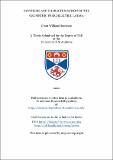Synthesis and characterisation of the geometric ferroelectric LaTaO₄
View/
Date
15/06/2022Author
Supervisor
Funder
Grant ID
EP/P024637/1
Metadata
Show full item recordAltmetrics Handle Statistics
Altmetrics DOI Statistics
Abstract
LaTaO₄ is one of very few reported n=2 Carpy-Galy oxides. It is isostructural to the BaMF₄ fluorides which were subject of much prior study due to their ferroelectric and multiferroic properties. Previous studies of LaTaO₄ have been consistent in their conclusion that it can adopt either a low temperature non-polar monoclinic, or high temperature polar orthorhombic phase, with the monoclinic – orthorhombic transition temperature (Tₘ₋ₒ) being dependent on the preparation method. Recent studies, however, have reported an unidentified dielectric anomaly in the orthorhombic phase which alludes to an additional subtle structural transition above Tₘ₋ₒ.
Powder neutron (PND) and electron diffraction studies have revealed that the previously unidentified dielectric anomaly denotes a transition between an incommensurately modulated and unmodulated orthorhombic (Cmc2₁) structure at ~503 K. The phase transition sequence is re-investigated in light of this new modulated phase, with resonant ultrasound (RUS) and Raman spectroscopy being utilised to elucidate the dynamics of transition and show the incommensurate – commensurate transition to be unusually 1ˢᵗ order, but nearly continuous (tri-critical).
Refinement of PND data in the Cmc2₁(α00)0s0 superspace group, indicates a modulation wavevector q = (0.456 0 0) at 483 K. The modulation arises from a variation in La³⁺ positions and octahedral tilts which propagate along the polar a-axis and is speculated to arise as a mechanism to improve overall bonding environment of La³⁺. Electron microscopy reveals that the modulation arises from partially ordered sub-units, which are 2.5× and 3× expansions of the original orthorhombic cell. A model has been constructed which combines the local structural origin with the observed macroscopic modulation, where sub-units partially order with an average periodicity of ~11a (~0.456 a*).
Previous studies report a relationship between the stability of each phase of LaTaO₄ and A-cation size. To explore the possibility that the modulation arises purely by an A-cation size effect, the series La₁₋ₓLnₓTaO₄ is synthesized, where Ln = Ce³⁺, Pr³⁺ and Nd³⁺ (0 ≤ x ≤ 0.3). Doping with these isovalent cations shows a general trend of stabilisation of the low temperature phases with decreasing average A-cation radii; the effect is amplified in Ce³⁺-doped samples and preliminary analysis suggests that this is due to a mix of oxidation states and the associated inter- and de-intercalation of interstitial oxygens during thermal cycling.
Type
Thesis, PhD Doctor of Philosophy
Rights
Embargo Reason: Embargo period has ended, thesis made available in accordance with University regulations
Collections
Description of related resources
Synthesis and Characterisation of the Geometric Ferroelectric LaTaO4 (thesis data) Howieson, G. W. University of St Andrews, 9 Nov 2023. DOI: 10.17630/a7540ced-d4a3-4c89-a93f-6e21dc2b4c01.Related resources
https://doi.org/10.17630/a7540ced-d4a3-4c89-a93f-6e21dc2b4c01Items in the St Andrews Research Repository are protected by copyright, with all rights reserved, unless otherwise indicated.

